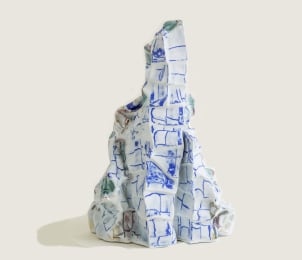
Hostler Burrows is pleased to present an exhibition of new work by Babs Haenen. This marks the artist’s first solo presentation with the gallery and serves to highlight the long and rich career that Haenen has sustained since 1979, and is a celebration of the vitality and exuberance with which she embraces both her life and work.
Babs Haenen creates evocative porcelain sculptures in which the aspects of form, line, and color bear equal weight and seem to “dance” together as one whole. Greatly influenced by abstract art, her works are expressed in a painterly fashion. Landscape motifs travel in freeform successions of contours and biomorphic waves; the sculptures brim with the movement of the natural world, recalling the vagaries of the wind, earth, water, and sky all at once.
Haenen’s work has been aligned with Organic Abstraction, and her techniques are deeply rooted in traditional Dutch ceramic art and pottery, as well as the Japanese and Chinese traditions. However, she has always been driven to reimagine the porcelain form; she challenges the decorative norms that are most commonly associated with ceramics and ceramic art.
She begins her process with slabs of porcelain, which she layers with pigment to form thin sheets. She then folds, cuts, and sculpts, manipulating the porcelain to create organic vessels and sculptures that are alive with inner movement. In a recent series she has reinterpreted paintings by some of the masters - Matisse, de Kooning - rendering, to marvelous effect, the movement and composition of paintings that we know well. She transforms the two dimensional into the three-dimensional; her sculptures abound with fluid color and pattern, echoing the movement in the paintings from which they are inspired. She does not distinguish between the interior and exterior of a vessel; the two are of equal importance. Haenen’s hand building technique allows for the work as a whole to be pigmented; color does not rest superficially in an exterior glaze but has dimension and moves throughout the porcelain in sharp lines or soft washes of tone. Where a painter might deftly wield a brush, she methodically sculpts and uses molds; the movement is gradual, an unveiling of gorgeously hued clays in rhythmic patterns manipulated through multiple firings.
Haenen's newest work is a further exploration of her “Mountain” series, abstracted yet further, appearing at times as “mountain buildings” - hybrids of nature and architecture. Do they represent a harmony between humans and nature? Are the two merging, or coexisting symbiotically? These pieces are aspirational; their vertical energy draws the gaze upward in movement that is almost spiritual, referencing the influence of the mythical mountains of China and the tradition of Scholar’s Rocks on Haenen’s Mountain Series. She presents these vessels in the same manner as the studied stones: slightly elevated - to be considered and meditated upon.
Haenen’s work does not simply adorn a room - it inhabits the space. It invokes reverence, invites stillness, slows our pace while we are near and rests in our consciousness after we’ve closed our eyes.